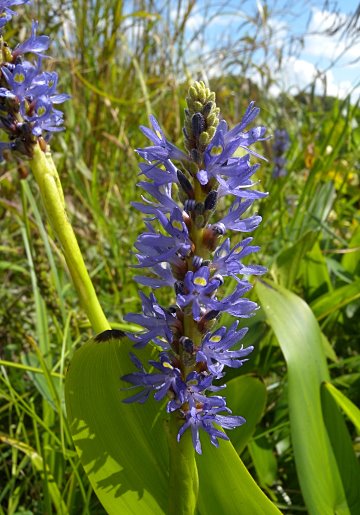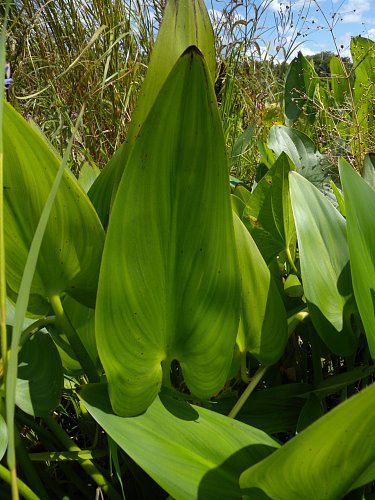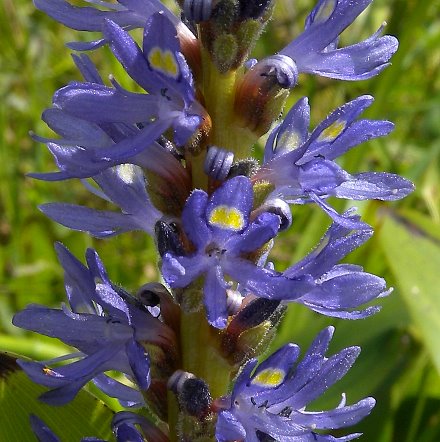Description: This perennial plant is about 1-3' tall, consisting of a loose clump of basal leaves and occasional flowering stalks. The basal leaves develop directly from the rootstock. The blades of these leaves are up to 7" long and 5" across across; the width of the blades can be highly variable. They are lanceolate-sagittate to oval-cordate in shape, medium green, smooth along the margins, and hairless. Along the upper surface, there are many fine parallel veins. The petioles of the basal leaves are as long as the blades or even longer; they are light to medium green, terete (round in cross-section), hairless, hollow, and rather stout. The unbranched flowering stalks are 1-3' long and ascending to erect; similar to the petioles, they are light green, terete, hairless, hollow, and stout. Each flowering stalk bears a single leaf that is similar to the basal leaves, except the base of its petiole is wrapped in a light green sheath. The stalk terminates in a single floral spike up to 5" long. Underneath this spike, there is a light green sheath that wraps around the stalk. Above this sheath, the central axis of the floral spike is glandular-pubescent. The blue-violet flowers and their buds are densely arranged all around the spike; a large spike can produce 100 or more flowers, although they don't bloom all at the same time.

Each flower spans
up to ½" across when it is fully open; the short blue-violet corolla
has 6 slender lobes (3 upper & 3 lower ones), which spread
outward from the throat of the flower. The uppermost lobe has 1-2 small
patches of yellow that probably function as nectar guides for visiting
insects. The reproductive organs of the flower consist of a single
style and 6 stamens of variable length (usually 3 long stamens
& 3 short stamens). Because of this variation, there are three
different morphological forms of the flower. The blooming period occurs
during the summer and early fall and can last several months for a
colony of plants. However, individual flowers last only a day or two.
The mature fruit of each flower has 3 cells, but only one of them
develops a seed. This seed is large in size. The root system consists
of long-running rhizomes and coarse fibrous roots. Clonal colonies
are often produced; sometimes, they can become quite large.
Cultivation:
The preferred growing conditions are full to partial sun and shallow
water to wet mucky soil. Pickerelweed is an emergent aquatic plant that
doesn't like to dry out.

Range &
Habitat:
The native Pickerelweed occurs in widely scattered locations across NE,
western,
and southern Illinois; it is absent from a large area of east-central
Illinois (see Distribution
Map). Populations of this plant have declined because of
habitat destruction. Habitats include shallow water of marshes, swamps,
bogs, ponds, and protected areas of rivers where the water is
slow-moving. Sometimes Pickerelweed can be found growing on mud during
dry weather, where it has a tendency to sprawl. This species is found
in higher quality wetlands.
Faunal Associations:
The nectar and pollen of the flowers attract Bombus spp. (Bumblebees)
and other bees, including Florilegus condigna, Melissodes
apicata, and Doufourea novaeangliae. The
latter two species are rare oligolectic visitors that collect the
pollen of Pickerelweed in particular to feed their larvae.
Occasionally, Sulfur Butterflies and other butterflies suck nectar from
the flowers. The larvae of some Borer Moths feed within the stalks and
leaf petioles of Pickerelweed, including Bellura densa
(Pickerelweed Borer Moth), Bellura gortynoides
(White-Tailed Diver), and Bellura obliqua (Cattail
Borer Moth). The young larvae of the White-Tailed Diver also mine the
leaf blades. Pickerelweed is the preferred host plant of the leaf
beetle, Donacia rugosa. The large edible seeds are
eaten occasionally by various ducks, including the Mallard, Black Duck,
Green-Winged Teal, and Wood Duck. Muskrats and White-Tailed Deer
occasionally browse on the foliage. When this plant forms dense
colonies, it provides cover for fish and other aquatic wildlife.

Photographic
Location:
Along the border of a pond at Weaver Park in Urbana, Illinois.
Comments:
Pickerelweed produces attractive spikes of blue-violet flowers, which
is an unusual color for the flowers of an emergent aquatic plant. This
species is related to the infamous Water Hyacinth (Eichhornia
crassipes), which clogs waterways in many areas of
southeastern United States. The introduced Water Hyacinth has similar
blue-violet flowers (although larger in size), but it has stubby leaves
that float on water. The smaller Heteranthera spp.
(Mud Plantains) are also related to Pickerelweed, but their flowers
occur individually or in small clusters. Both Water Hyacinth and Mud
Plantains have been found in wetlands of southern Illinois.